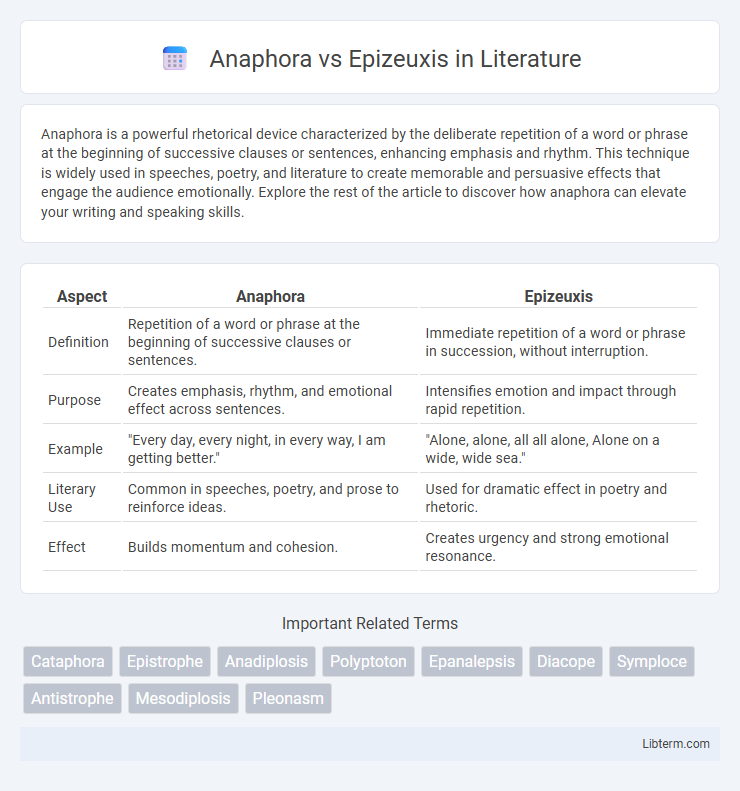Anaphora is a powerful rhetorical device characterized by the deliberate repetition of a word or phrase at the beginning of successive clauses or sentences, enhancing emphasis and rhythm. This technique is widely used in speeches, poetry, and literature to create memorable and persuasive effects that engage the audience emotionally. Explore the rest of the article to discover how anaphora can elevate your writing and speaking skills.
Table of Comparison
| Aspect | Anaphora | Epizeuxis |
|---|---|---|
| Definition | Repetition of a word or phrase at the beginning of successive clauses or sentences. | Immediate repetition of a word or phrase in succession, without interruption. |
| Purpose | Creates emphasis, rhythm, and emotional effect across sentences. | Intensifies emotion and impact through rapid repetition. |
| Example | "Every day, every night, in every way, I am getting better." | "Alone, alone, all all alone, Alone on a wide, wide sea." |
| Literary Use | Common in speeches, poetry, and prose to reinforce ideas. | Used for dramatic effect in poetry and rhetoric. |
| Effect | Builds momentum and cohesion. | Creates urgency and strong emotional resonance. |
Understanding Anaphora and Epizeuxis
Anaphora is the deliberate repetition of a word or phrase at the beginning of successive clauses or sentences to create emphasis and enhance rhythm in writing or speech. Epizeuxis involves the immediate repetition of a word or phrase within the same sentence for intense emotional effect or strong reinforcement. Both rhetorical devices serve distinct purposes: anaphora builds momentum and cohesion across multiple clauses, while epizeuxis delivers concentrated impact through rapid reiteration.
Defining Anaphora in Rhetoric
Anaphora in rhetoric is the deliberate repetition of a word or phrase at the beginning of successive clauses or sentences to create emphasis and rhythm. This technique enhances coherence and emotional impact by reinforcing key ideas, making the argument more memorable. Unlike epizeuxis, which involves immediate repetition of words within a single clause, anaphora spans multiple clauses, providing a structured rhetorical effect.
What is Epizeuxis?
Epizeuxis is a rhetorical device characterized by the immediate repetition of a word or phrase within a single sentence or clause to create emphasis and intensity. Unlike anaphora, which repeats words at the beginning of successive clauses or sentences, epizeuxis places repeated words directly next to each other for dramatic effect. This technique is commonly used in literature, speeches, and poetry to amplify emotions and reinforce key concepts.
Structural Differences Between Anaphora and Epizeuxis
Anaphora involves the repetition of a word or phrase at the beginning of successive clauses or sentences, creating a rhythmic and emphatic effect through structured recurrence. Epizeuxis features the immediate repetition of a single word or phrase within the same clause or sentence, intensifying emotional impact and urgency. The structural difference lies in anaphora's repetition across multiple units versus epizeuxis's consecutive repetition within a single unit.
Functions of Anaphora in Writing
Anaphora enhances writing by creating rhythm and reinforcing key ideas through the deliberate repetition of words or phrases at the beginning of successive sentences or clauses. This rhetorical device strengthens emotional appeal and emphasizes important themes, making the message more memorable for readers. Writers often employ anaphora to build momentum and unify diverse points within a cohesive narrative structure.
The Impact of Epizeuxis on Emphasis
Epizeuxis intensifies emphasis by repeating a word or phrase consecutively in close succession, creating a powerful auditory effect that captures the audience's attention and reinforces the significance of the message. Unlike anaphora, which repeats phrases at the beginning of successive clauses or sentences to build rhythm and cohesion, epizeuxis drives immediacy and urgency through its concentrated repetition. This technique is often used in speeches, poetry, and advertising to evoke strong emotions or highlight critical points, making the repeated term resonate more deeply with the listener or reader.
Common Examples of Anaphora
Anaphora is a rhetorical device characterized by the repetition of a word or phrase at the beginning of successive clauses, commonly seen in Martin Luther King Jr.'s "I Have a Dream" speech repeating "I have a dream." Epizeuxis, in contrast, involves immediate repetition of a word or phrase within the same clause, such as in Shakespeare's "O Romeo, Romeo! wherefore art thou Romeo?" Common examples of anaphora include Charles Dickens' "It was the best of times, it was the worst of times," and Winston Churchill's "We shall fight on the beaches, we shall fight on the landing grounds.
Memorable Uses of Epizeuxis
Epizeuxis is a rhetorical device characterized by the immediate repetition of a word or phrase to create emphasis and enhance memorability, as famously used by Shakespeare in "Tomorrow, and tomorrow, and tomorrow" from Macbeth. Unlike anaphora, which repeats words at the beginning of successive clauses, epizeuxis intensifies emotion by rapid recurrence, seen in Martin Luther King Jr.'s "I have a dream, I have a dream." Memorable epizeuxis often makes speeches and literature resonate deeply, reinforcing key ideas through rhythmic and powerful repetition.
Anaphora vs Epizeuxis: Key Distinctions
Anaphora and epizeuxis are rhetorical devices that involve repetition, but they differ significantly in placement and effect. Anaphora repeats a word or phrase at the beginning of successive clauses or sentences, enhancing emphasis and rhythm, while epizeuxis involves immediate repetition of the same word or phrase within a single clause for intensified impact. Key distinctions include anaphora's structural repetition across multiple phrases versus epizeuxis's concentrated repetition for emotional or emphatic emphasis.
Choosing the Right Device for Your Message
Anaphora and epizeuxis both serve to emphasize key ideas through repetition, but their effectiveness depends on the message's tone and rhythm. Anaphora repeats words or phrases at the beginning of successive clauses, creating a measured, persuasive flow suited for speeches or formal writing. Epizeuxis, with immediate repetition of a word for intense emphasis, works best in emotional or dramatic contexts where urgency and passion need to be conveyed.
Anaphora Infographic

 libterm.com
libterm.com